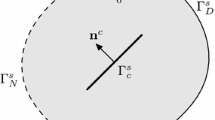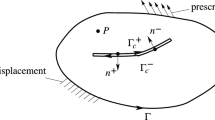Abstract
Applications of the boundary element method (BEM) and the finite element method (FEM), to the analysis of two-dimensional problems of moving cracks in creeping bodies, is the subject of this paper. In the absence of an acceptable crack growth law valid under small scale transient as well as extended steady state creep conditions, the computer simulations are carried out here for crack extension at prescribed constant speeds. It is shown here that the BEM is most effective for the analysis of transient crack growth under small scale creep conditions while the FEM appears to be best suited for the study of crack growth under conditions of extensive creep throughout most of the structure. These two methods, therefore, tend to complement each other for this class of problems. It is felt that the numerical methods presented here can, in conjunction with experiments, be very useful for the evaluation of existing crack growth laws as well as for the development of new ones.
Résumé
Le sujet du mémoire est l'application de la méthode par valeurs aux limites (BEM) et de la méthode par éléments finis (FEM) à l'analyse de problèmes bidimensionnels de fissures en extension dans des composants soumis à fluage.
En l'absence d'une loi d'extension de fissure qui soit applicable tant sous des conditions de fluage transitoire à petite échelle que de fluage stable généralisé, on procède aux simulations per calcul on considérant le développement d'une fissure à des vitesses constantes fixées.
On montre que la méthode BEM est plus efficace pour analyser la croissance d'une fissure de fluage en régime transitoire à une petite échelle, tandis que la méthode FEM convient le mieux pour étudier la croissance d'une fissure dans des conditions de fluage s'étendant à l'ensemble du composant.
Dès lors, les deux méthodes tendent à se compléter pour cette classe de problèmes. On estime que les méthodes numériques qui sont présentées ici, peuvent être très utiles, en association avec des essais, pour évaluer les lois existantes en matière de propagation de fissures, ainsi que pour en développer de nouvelles.
Similar content being viewed by others
References
R. Koterazawa and Y. Iwata, Journal of Engineering Materials and Technology, Transactions ASME (1976) 296-304.
M.P. Harper and E.G. Ellison, Strain Analysis (1977) 167–179.
P. Shahinian and K. Sadananda, in ASME-MPC Symposium on Creep Fatigue Interaction, ASME (1976) 365–390.
D.J. Smith and G.A. Webster, Strain Analysis 16 (1981) 37–143.
A. Saxena, T.T. Shih and H.A. Ernst, “Wide Range Creep Crack Growth Rate Behavior of A470 Class 8 (Cr-Mo-V) Steel,” Westinghouse Scientific Paper 82-1D7-EVFLA-P1 (February 1982).
K. Sadananda and P. Shahinian, Transactions ASME, Journal of Engineering Materials and Technology 100 (1978) 381–387.
H. Riedel, Zeitschrift für Metallkunde 69 (1978) 755–760.
H. Riedel and J.R. Rice, Tensile Cracks in Creeping Solids, ASTM STP 700, American Society for Testing Materials (1980) 112–130.
C.Y. Hui and H. Riedel, International Journal of Fracture (1981) 409–425.
J. Hutchinson, “Constitutive Behavior and Crack Tip Fields for Materials Undergoing Creep-Constrained Grain Boundary Cavitation,” Report No. MECH 34, Division of Applied Sciences, Harvard University, Cambridge, MA (1982).
S. Mukherjee, Boundary Element Method in Creep and Fracture, Applied Science Publishers Ltd., Barking, Essex, England (1982).
S. Mukherjee and V. Banthia, in Developments in Boundary Element Methods, Vol. 3 P.K. Banerjee and S. Mukherjee (eds.), Applied Science Publishers, London (1984) 87–114.
J.L. Bassani and F.A. McClintock, International Journal of Solids and Structures 17 (1981) 479–492.
N.I. Muskhelishvili, Some Basic Problems of the Mathematical Theory of Elasticity (Trans. J.R.M. Radok), Noordhoff, Groningen (1953).
S.K. Chan, I.S. Tuba and W.K. Wilson, Engineering Fracture Mechanics 2 (1980) 1–17.
P. Tong and T.H.H. Pian, International Journal of Solids and Structures 9 (1973) 313–321.
P. Tong and T.H.H. Pian, International Journal of Numerical Methods in Engineering (1973) 297-308.
E. Byskov, International Journal of Fracture Mechanics 6 (1970) 159–167.
S.E. Benzley, International Journal of Numerical Methods in Engineering 3 (1974) 537–545.
D.M. Tracy, Engineering Fracture Mechanics 3 (1971) 255–265.
R.D. Henshell and K.G. Shaw, International Journal of Numerical Methods in Engineering 9 (1975) 495–509.
R.S. Barsoum, International Journal of Fracture 10 (1974) RCR 603–605.
H.D. Hibbit, International Journal of Numerical Methods in Engineering 11 (1977) 180–184.
R.S. Barsoum, International Journal of Numerical Methods in Engineering 10 (1976) 25–37.
A.R. Ingraffea, private communications.
N. Levy, P.V. Marcal, W.J. Ostergren and J.R. Rice, International Journal of Fracture Mechanics 7 (1971) 143–156.
R.S. Barsoum, International Journal of Numerical Methods in Engineering 11 (1977) 85–98.
V. Banthia, International Journal for Numerical Methods in Engineering (In press).
G.H. Staab, Computers and Structures 17 (1983) 449–457.
T.J.R. Hughes and J.E. Akin, International Journal of Numerical methods in Engineering 15 (1980) 733–752.
D.M. Tracey and T.S. Cook International Journal of Numerical methods in Engineering 11 (1977) 1225–1234.
O.C. Zienkiewicz and I.C. Cormeau International Journal of Numerical Methods in Engineering 8 (1974) 821–845.
O.C. Zienkiewicz, The Finite Element Method, McGraw-Hill, New York (1979).
R.H. Gallaghar, Finite Element Analysis, Prentice-Hall Inc., Englewood Cliffs, NJ (1975)
V.K. Banthia, “Numerical Analysis of Time-dependent Inelastic Fracture,” Ph.D. thesis, Department of Theoretical and Applied mechanics, Cornell University, Ithaca, NY (1984).
Author information
Authors and Affiliations
Rights and permissions
About this article
Cite this article
Banthia, V., Mukherjee, S. BEM and FEM analysis of planar moving cracks in creeping solids. Int J Fract 28, 83–101 (1985). https://doi.org/10.1007/BF00018586
Received:
Revised:
Issue Date:
DOI: https://doi.org/10.1007/BF00018586




